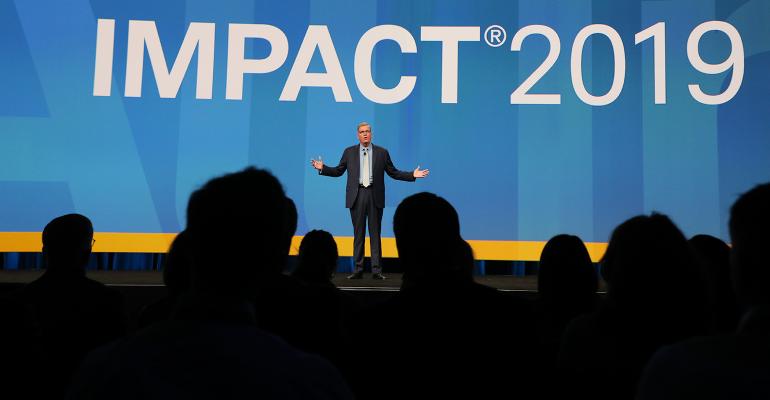Bernie Clark, EVP and head of Schwab Advisor Services, said Friday that while no final decisions have been made on the advisor technology road map it will follow as it prepares to swallow smaller rival TD Ameritrade, whatever comes out on the other side of the acquisition will be the best combination of technology from each of the custodians.
Advisors have voiced concern that Schwab's acquisition of TD Ameritrade would mean pulling the plug on Veo One, TDAI's open-architecture technology platform that lets advisors plug and play any number of third-party tech vendors creating tools for an advisor's practice. Schwab's technology platform for advisors, Schwab Advisor Center, is viewed as maintaining a tighter control of the third-party environment and being less flexible to advisor customization.
But despite fears, Schwab executives are not planning to ditch Veo One in favor of their own current technology, Clark said, though the final product will likely not be called Veo One. The firm has pledged, however, to provide "the best in-class technology and an open architecture," Clark said during an interview Friday with Wealthmanagement.com. It will not simply be a case of airdropping all TDAI advisors onto Schwab's platform as it currently stands.
Those concerns were exacerbated by comments made on the firm's 2020 Winter Business Update call Feb. 4, when COO Joe Martinetto said that “we expect the Schwab systems to be the platforms of choice." Schwab has been busy with its own “digital platform evolution and transformation," he added.
Martinetto went on to say that there would be exceptions made for situations “where there’s a clear material advantage in what the TD Ameritrade approach brings.” Those occurrences and platforms, however, have yet to be named.
Clark said that discussions were already taking place regarding the integration. Meanwhile, Schwab is proceeding to improve its own technology, he said. “We have an array of initiatives that are well underway,” he added. “We’re modernizing our platforms and doing quite a bit of changes already.”
Schwab hasn’t explicitly indicated what components of the technology will survive the gauntlet, or in what combination. But at the end of the day, the “look and feel” of the tech platform, post-merger, “may look more similar to the advisors on Schwab’s platform,” said Clark, quickly adding that it was “way too soon to say that.”
But the vague pledge still leaves questions, posed by the proposed merger, that remain unanswered as advisors and third-party technology firms struggle to decode which platform the combined firm will employ going forward.
The stakes are high, especially for TD Ameritrade Institutional advisors, who have grown used to the plethora of open architecture third-party solutions available today, particularly bi-directional data-sharing integrations built using the “sandbox”-like development approach of TDAI’s Veo One.
For the past few months, since the Schwab-TD merger was announced in late November, John Mackowiak, chief business development officer at Advyzon, has been fielding several questions a week about how his cloud-based wealth management platform will weather the transition. Advyzon is integrated with both Veo One and Schwab Advisor Center and has been in communication with both firms.
Another vendor that utilizes Veo One, financial planning software provider RightCapital, noted that it hadn’t seen any negative impact in the support provided by TDAI following the merger announcement. “If the combined organization were to decide to make changes to [the] Veo system, post-merger, I believe that Schwab-TD will work closely with all partners so everyone can plan ahead,” said Shuang Chen, co-founder and CEO of RightCapital. “I don’t see a scenario where abrupt changes are made to a complex system like Veo. That is not in the best interest of anyone involved.”
Executives at Riskalyze are planning for Schwab to eventually run the platform show, should the deal go forward. “It appears that Veo will be replaced by Schwab's platform and technology,” said Aaron Klein, CEO of the risk metrics software provider. “It's our expectation that advisors on the Riskalyze platform won't see any negative effects from the merger.”
Service disruptions are the last thing anyone wants to see. “As long as the data feed connections are not disrupted, then it should be business as usual for everybody,” Mackowiak said. But if one platform supplants the other, “there’ll be a little bit of a learning curve,” he acknowledged.
While remaining circumspect, it appears Schwab is positioning Mackowiak and others familiar with the TD platform for an impending learning curve.
But Schwab may stop at the point of spinning off the Veo platform and selling it to a third party. "We are in the business of bringing the firms together, not tearing them apart," said Clark. "I’ll leave it at that."
Clark pointed out that TD Ameritrade was also a player in the merger and reminded advisors that the two were still technically competitors at this point. To that end, TDAI advisors that want to communicate which of their third-party applications they would most like to see added to the Schwab platform should be communicating with TD, not Schwab, he said. "That’s really a job for TD at this point," he added.
Despite the conference calls and interviews, the merger process has been a reminder for advisors that, in some cases, they're just passengers with someone else at the wheel. At the end of the day, not everyone will get exactly what they want, and that might mean saying goodbye to technology they've grown to love.
Will advisors get a say in which platform they prefer? “This is one of those things,” said Clark. “I’m not sure they do.”





